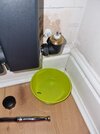Hi,
I have a new vertical rad, TRV is fitted to the return. On the opposite side, rather than a lockshield looking valve it looks a bit different and im wondering if it would work in the same way, the plumber was a bit confused by it aswell and basically said we could have TRV on either side.
Please see picture.
I stupidly thought i was turning the lockshield valve when i turned the gold nut attatched to the gold plate, after a few turns suddenly water started spraying out, in a panic i tried to retighten it and eventually it sealed, kept an eye on it and it hasent leaked since, although a bit of rubber has come off from somewhere and im a bit worried where it could have come off?
If its not leaking after 24 hours do you think it will be okay?
Is it the white small nut on top of the gold nut which will act as a lockshield type valve, i.e. anticlockwise to fully open and clockwise to fully close?
I have a new vertical rad, TRV is fitted to the return. On the opposite side, rather than a lockshield looking valve it looks a bit different and im wondering if it would work in the same way, the plumber was a bit confused by it aswell and basically said we could have TRV on either side.
Please see picture.
I stupidly thought i was turning the lockshield valve when i turned the gold nut attatched to the gold plate, after a few turns suddenly water started spraying out, in a panic i tried to retighten it and eventually it sealed, kept an eye on it and it hasent leaked since, although a bit of rubber has come off from somewhere and im a bit worried where it could have come off?
If its not leaking after 24 hours do you think it will be okay?
Is it the white small nut on top of the gold nut which will act as a lockshield type valve, i.e. anticlockwise to fully open and clockwise to fully close?


